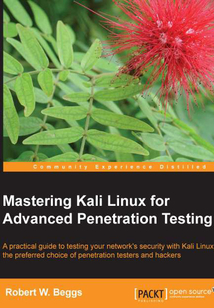舉報 

會員
Mastering Kali Linux for Advanced Penetration Testing
最新章節:
Index
Thisbookprovidesanoverviewofthekillchainapproachtopenetrationtesting,andthenfocusesonusingKaliLinuxtoprovideexamplesofhowthismethodologyisappliedintherealworld.Afterdescribingtheunderlyingconcepts,step-by-stepexamplesareprovidedthatuseselectedtoolstodemonstratethetechniques.IfyouareanITprofessionalorasecurityconsultantwhowantstomaximizethesuccessofyournetworktestingusingsomeoftheadvancedfeaturesofKaliLinux,thenthisbookisforyou.Thisbookwillteachyouhowtobecomeanexpertinthepre-engagement,management,anddocumentationofpenetrationtestingbybuildingonyourunderstandingofKaliLinuxandwirelessconcepts.
目錄(107章)
倒序
- coverpage
- Mastering Kali Linux for Advanced Penetration Testing
- Credits
- About the Author
- About the Reviewers
- www.PacktPub.com
- Support files eBooks discount offers and more
- Preface
- The "Kill Chain" approach to penetration testing
- What this book covers
- What you need for this book
- Who this book is for
- Conventions
- Reader feedback
- Customer support
- Disclaimer
- Part 1. The Attacker's Kill Chain
- Chapter 1. Starting with Kali Linux
- Kali Linux
- Configuring network services and secure communications
- Updating Kali Linux
- Configuring and customizing Kali Linux
- Managing third-party applications
- Effective management of penetration tests
- Summary
- Chapter 2. Identifying the Target – Passive Reconnaissance
- Basic principles of reconnaissance
- Open Source intelligence
- DNS reconnaissance and route mapping
- Obtaining user information
- Profiling users for password lists
- Summary
- Chapter 3. Active Reconnaissance and Vulnerability Scanning
- Stealth scanning strategies
- Identifying the network infrastructure
- Enumerating hosts
- Port operating system and service discovery
- Employing comprehensive reconnaissance applications
- Vulnerability scanning
- Summary
- Chapter 4. Exploit
- Threat modeling
- Using online and local vulnerability resources
- Exploiting multiple targets with Armitage
- Bypassing IDs and antivirus detection
- Summary
- Chapter 5. Post Exploit – Action on the Objective
- Bypassing Windows User Account Control
- Conducting a rapid reconnaissance of a compromised system
- Finding and taking sensitive data – pillaging the target
- Creating additional accounts
- Using Metasploit for post-exploit activities
- Escalating user privileges on a compromised host
- Replaying authentication tokens using incognito
- Accessing new accounts with horizontal escalation
- Covering your tracks
- Summary
- Chapter 6. Post Exploit – Persistence
- Compromising the existing system and application files for remote access
- Using persistent agents
- Maintaining persistence with the Metasploit Framework
- Creating a standalone persistent agent with Metasploit
- Redirecting ports to bypass network controls
- Summary
- Part 2. The Delivery Phase
- Chapter 7. Physical Attacks and Social Engineering
- Social Engineering Toolkit
- Using the PowerShell alphanumeric shellcode injection attack
- Hiding executables and obfuscating the attacker's URL
- Escalating an attack using DNS redirection
- Physical access and hostile devices
- Summary
- Chapter 8. Exploiting Wireless Communications
- Configuring Kali for wireless attacks
- Wireless reconnaissance
- Bypassing a Hidden Service Set Identifier
- Bypassing the MAC address authentication
- Compromising a WEP encryption
- Attacking WPA and WPA2
- Cloning an access point
- Denial-of-service attacks
- Summary
- Chapter 9. Reconnaissance and Exploitation of Web-based Applications
- Conducting reconnaissance of websites
- Vulnerability scanners
- Testing security with client-side proxies
- Server exploits
- Application-specific attacks
- Maintaining access with web backdoors
- Summary
- Chapter 10. Exploiting Remote Access Communications
- Exploiting operating system communication protocols
- Exploiting third-party remote access applications
- Attacking Secure Sockets Layer
- Attacking an IPSec Virtual Private Network
- Summary
- Chapter 11. Client-side Exploitation
- Attacking a system using hostile scripts
- The Cross-Site Scripting Framework
- The Brower Exploitation Framework – BeEF
- A walkthrough of the BeEF browser
- Summary
- Appendix A. Installing Kali Linux
- Downloading Kali Linux
- Basic Installation of Kali Linux
- Setting up a test environment
- Index 更新時間:2021-07-16 11:33:50
推薦閱讀
- 黑客攻防技巧
- INSTANT Metasploit Starter
- Enterprise Cloud Security and Governance
- 走進新安全:讀懂網絡安全威脅、技術與新思想
- Web安全與攻防入門很輕松(實戰超值版)
- .NET安全攻防指南(上冊)
- 模糊測試:強制發掘安全漏洞的利器
- Falco云原生安全:Falco原理、實踐與擴展
- 網絡用戶行為的安全可信分析與控制
- 空間群組密鑰管理研究:基于自主的深空DTN密鑰管理
- INSTANT Apple Configurator How-to
- 隱私計算:推進數據“可用不可見”的關鍵技術
- VMware vCloud Security
- 網絡空間安全導論
- 網絡攻防實戰研究:MySQL數據庫安全
- 計算機系統與網絡安全研究
- 信息組織
- Metasploit 5.0 for Beginners
- Instant OSSEC Host-based Intrusion Detection System
- 數據恢復技術深度揭秘
- 互聯網域名國際化與安全技術導論
- 2023—2024年中國網絡安全發展藍皮書
- ATT&CK框架實踐指南(第2版)
- 復雜網絡環境下訪問控制技術
- INSTANT Penetration Testing:Setting Up a Test Lab How-to
- 商用密碼與安全性評估
- iOS黑客攻防秘籍(第2版)
- 小小黑客之路
- 計算機網絡安全原理
- 黑客

